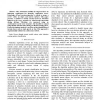Free Online Productivity Tools
i2Speak
i2Symbol
i2OCR
iTex2Img
iWeb2Print
iWeb2Shot
i2Type
iPdf2Split
iPdf2Merge
i2Bopomofo
i2Arabic
i2Style
i2Image
i2PDF
iLatex2Rtf
Sci2ools
ICRA
2005
IEEE
2005
IEEE
Vibration-based Terrain Analysis for Mobile Robots
—Safe, autonomous mobility in rough terrain is an important requirement for planetary exploration rovers. Knowledge of local terrain properties is critical to ensure a rover’s safety on slopes and uneven surfaces. This paper presents a method to classify terrain based on vibrations induced in the rover structure by wheel-terrain interaction during driving. Vibrations are measured using an accelerometer on the rover structure. The classifier is trained using labeled vibration data during an off-line learning phase. Linear discriminant analysis is used for on-line identification of terrain classes such as sand, gravel, or clay. This approach is experimentally validated on a laboratory testbed.
| Added | 25 Jun 2010 |
| Updated | 25 Jun 2010 |
| Type | Conference |
| Year | 2005 |
| Where | ICRA |
| Authors | Christopher A. Brooks, Karl Iagnemma, Steven Dubowsky |
Comments (0)

